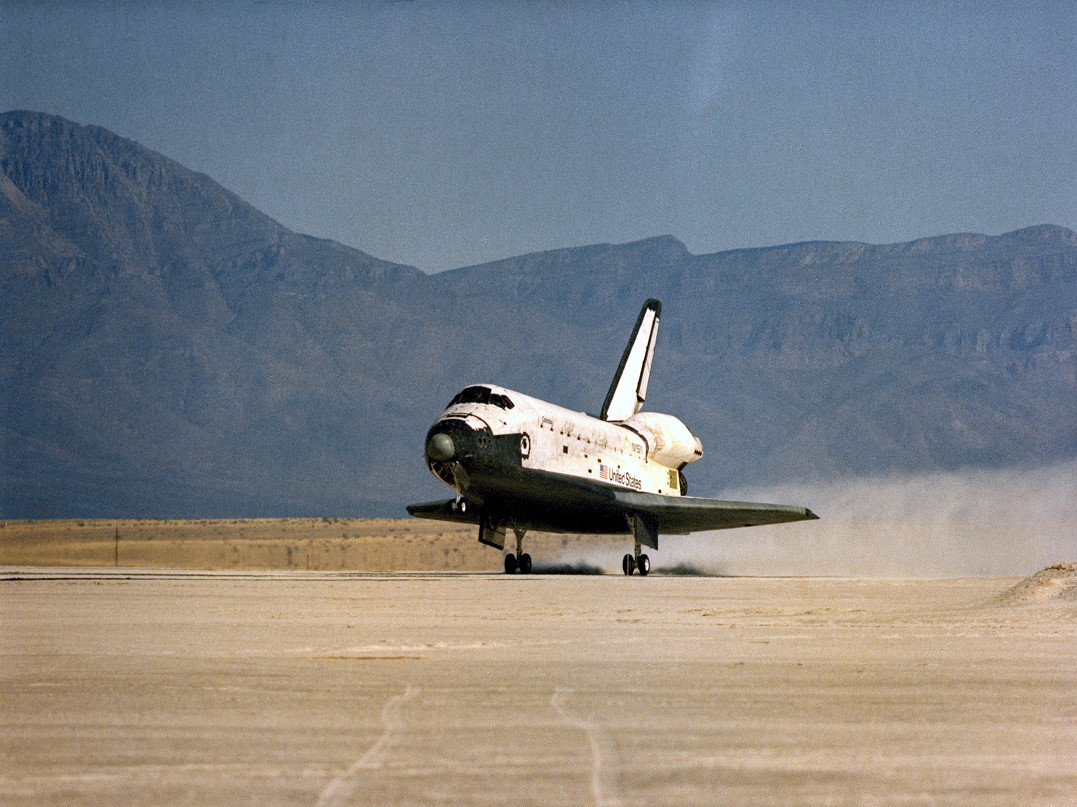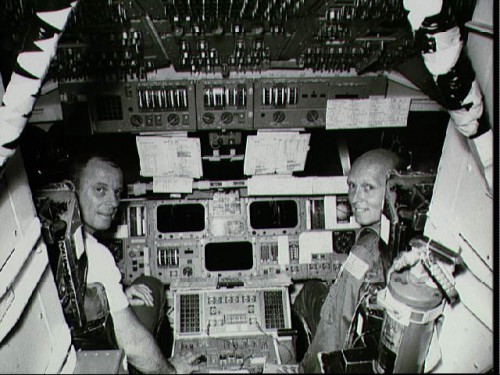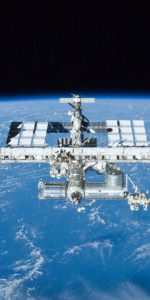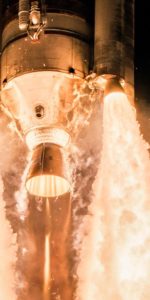
Almost four decades ago, and two years ahead of the first Space Shuttle launch, NASA took the unusual step of selecting a great white blotch of compacted salt and gypsum in New Mexico’s Tularosa Valley as a potential landing site. Even before the maiden flight of Columbia, it had long been planned for the primary end-of-mission landing sites to be Edwards Air Force Base, Calif., and, later, the Kennedy Space Center (KSC) in Florida. However, the tertiary site of White Sands, selected by NASA in March 1979, offered year-round near-perfect weather and a vast runway, with ample margins of safety. In March 1982—35 years ago, this month—that safety net was called upon for the first and only time in shuttle history, supporting a dramatic landing which caused more than a few hearts to jump into throats.
White Sands is an enormous place. Its size and color make it virtually unobstructed and visible from space. It lies in a mountain-ringed region called “Alkali Flats” and was first employed by Northrop Aviation in the 1940s to test military target drones. It quickly acquired the nickname “Northrop Strip”, which later became corrupted into “Northrup Strip”, following a typo on a press release. The new name stuck, and by 1952 “Northrup” had become part of White Sands Missile Range, with a pair of 6.6-mile-long (10.6 km) runways crossing each other in an X shape. During the first two shuttle missions in 1981, it was held in reserve in case an emergency demanded an immediate return to Earth after the first orbit. “Should the orbiter not be in a safe orbit,” noted a NASA press release, “the spacecraft would be slowed down by a de-orbit burn, high over the South Pacific, east of Samoa. The flight path would cross Baja California and the Mexican state of Senora, until the spacecraft was in the denser atmosphere and the crew would fly it, “dead-stick”, into Northrup Strip.”
Right up until the very end of the shuttle era in July 2011, White Sands remained on NASA’s list of contingency landing sites and astronauts routinely honed their skills there. Although it only saw one orbiter—Columbia on STS-3 in March 1982—touch down on its hard-packed runway surface, the area almost saw service a second time in December 2006, when the returning crew of Discovery on STS-116 were temporarily thwarted in their efforts to land by poor weather at both Edwards and KSC. Ultimately, they landed at Edwards.

Like the crew of STS-116 which followed it, the astronauts of STS-3 were not supposed to land in New Mexico at all. In fact, launched on 22 March 1982, theirs was a scheduled seven-day flight to demonstrate the shuttle’s capabilities as a platform for scientific experiments. During their time aloft, Skylab veteran Jack Lousma and Pilot Gordon Fullerton evaluated Columbia’s robotic arm and supported a multitude of payloads, devoted to a variety of disciplines from plant seeds to space science.
Even before launch, however, their landing site carried a big question mark. Officially, they would touch down on the dry lakebed Runway 23 at Edwards—as previously done by the crews of STS-1 and STS-2—but unseasonal rain showers had left it under several inches of water. Four days before STS-3 set off, hoping to err on the side of caution, NASA called up White Sands as a backup option. By an enormous stroke of ill-fortune, and despite having 90-percent year-round near-perfect weather, White Sands was assailed by its worst wind and sand storm in 25 years.
And the storm came on 29 March 1982; the very day that Lousma and Fullerton were due to return to Earth…
Based in New Mexico at the time, supporting the landing, was “rookie” astronaut Charlie Bolden, who recalled the storm for a NASA oral history interview. “This dust storm was unlike anything I’d ever seen,” Bolden recalled. “It’s gypsum and it’s very fine, like talcum powder. Everything was covered in plastic, the windows were sealed, but it didn’t make any difference. That was a hint that this was not a good place to land the shuttle!”
Early on the 29th, less than a half-hour before their de-orbit burn, Mission Control advised Lousma and Fullerton that conditions at Edwards were unacceptable. Moreover, the deteriorating situation at White Sands offered no alternative but to remain aloft for another 24 hours. For the astronauts, it was an opportunity for a little extra time in weightlessness. “It was terrific,” remembered Fullerton in his NASA oral history. “We watched the world and I wouldn’t have had it any other way. In fact, we flew right over White Sands, with the nose pointing straight down, and I could see this monster storm going on there. It looked like it was headed for Texas!” In Fullerton’s mind, the decision to wave-off both Edwards and White Sands was the only logical choice.
Meanwhile, Chief Astronaut John Young—veteran of the first shuttle mission—had flown several weather reconnaissance sorties over the New Mexico site and reported that conditions were far from optimum for STS-3 to land. Sand drifts had even blown into the public affairs area and gathered against the sides of buildings, reaching depths of 2 feet (60 cm) or more in places. “The runway got eroded by the wind,” recalled Grady McCright, the White Sands facility manager, in his NASA oral history, “so we had people driving a road grader that night to grade it, compact it and get it ready for landing the next morning. The wind didn’t quit blowing until dark that night.”
By daybreak on 30 March 1982, the storm had subsided and Lousma and Fullerton resumed their preparations for re-entry into the atmosphere, bound for White Sands.
Yet the hands of fate still had one more card to play in perhaps the most dramatic landing ever performed in the Space Shuttle era.
The second part of this article will appear tomorrow.
Be sure to “LIKE” AmericaSpace on Facebook and follow us on Instagram & Twitter!






We were cleaning sand out of the main engine compartment for weeks. It was jokingly said that it would be better to crash rather than land at White Sands again.
Yeah, what an adventure! I still have gypsum sand in my camera gear and telescope, the stuff is insidious. I’ve been in many desert storms, but never anything like that. I get all choked up looking at my photos of that crowd of 300,000+ people, all camping in such horrible conditions for the chance to see a spaceship land on earth.
Next to the exuberant throng of space enthusiasts, the double boom then landing of Columbia, the most memorable event was when the wind blew over a porta potty with one of my crewmates inside! Needless to say, on the trip back to the hotel, the smell emanating from George was um…unforgettable.